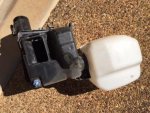MiddleAgeSubie
Forum Member
- Joined
- Dec 15, 2013
- Messages
- 990
- Location
- AZ
- Car Year
- 2018 / 2008
- Car Model
- 4Runner / Tribeca
- Transmission
- 5EAT
We have a pretty good thread about water crossings in general:
https://www.offroadsubarus.com/showthread.php?t=4845&highlight=fording
But I like numbers. This thread is thus about numbers, not water flow rates or how to dodge white sharks while driving from Sydney to San Francisco.
We all know that Subaru recommends water no deeper than the undercarriage.
1/Tell us about the ground clearance of your car: what lift, if any. Of course, tell us if your car has been specifically modified to cope with water.
2/How deep you go without much concern? Either depth or a recognizable point on car.
3/How deep you would go with some extra prep (covering the front, stopping fans, etc).
4/What is the deepest you would do after the best prep you can do? This assumes your other options are dismal enough to make the risk worth taking.
5/Any surprising mishaps that should not have happened but did?
https://www.offroadsubarus.com/showthread.php?t=4845&highlight=fording
But I like numbers. This thread is thus about numbers, not water flow rates or how to dodge white sharks while driving from Sydney to San Francisco.
We all know that Subaru recommends water no deeper than the undercarriage.
1/Tell us about the ground clearance of your car: what lift, if any. Of course, tell us if your car has been specifically modified to cope with water.
2/How deep you go without much concern? Either depth or a recognizable point on car.
3/How deep you would go with some extra prep (covering the front, stopping fans, etc).
4/What is the deepest you would do after the best prep you can do? This assumes your other options are dismal enough to make the risk worth taking.
5/Any surprising mishaps that should not have happened but did?


